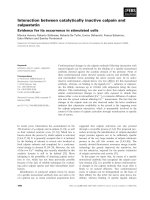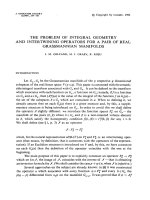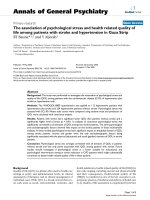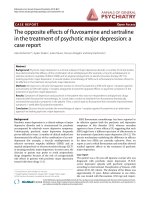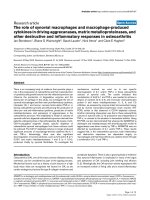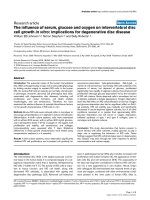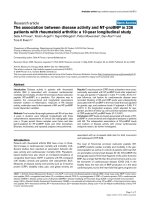Báo cáo y học: "The SLC2A9 non-synonymous Arg265His variant and gout; evidence for a population-specific effect on severit" docx
Bạn đang xem bản rút gọn của tài liệu. Xem và tải ngay bản đầy đủ của tài liệu tại đây (875.46 KB, 25 trang )
This Provisional PDF corresponds to the article as it appeared upon acceptance. Copyedited and
fully formatted PDF and full text (HTML) versions will be made available soon.
The SLC2A9 non-synonymous Arg265His variant and gout; evidence for a
population-specific effect on severity
Arthritis Research & Therapy 2011, 13:R85 doi:10.1186/ar3356
Jade E Hollis-Moffatt ()
Peter J Gow ()
Andrew A Harrison ()
John Highton ()
Peter BB Jones ()
Lisa K Stamp ()
Nicola Dalbeth ()
Tony R Merriman ()
ISSN 1478-6354
Article type Research article
Submission date 5 January 2011
Acceptance date 9 June 2011
Publication date 9 June 2011
Article URL />This peer-reviewed article was published immediately upon acceptance. It can be downloaded,
printed and distributed freely for any purposes (see copyright notice below).
Articles in Arthritis Research & Therapy are listed in PubMed and archived at PubMed Central.
For information about publishing your research in Arthritis Research & Therapy go to
/>Arthritis Research & Therapy
© 2011 Hollis-Moffatt et al. ; licensee BioMed Central Ltd.
This is an open access article distributed under the terms of the Creative Commons Attribution License ( />which permits unrestricted use, distribution, and reproduction in any medium, provided the original work is properly cited.
1
The SLC2A9 non-synonymous Arg265His variant and gout; evidence for a population-
specific effect on severity
Jade E Hollis-Moffatt
1
, Peter J Gow
2
, Andrew A Harrison
3
, John Highton
4
, Peter BB Jones
5
,
Lisa K Stamp
6
, Nicola Dalbeth
5
and Tony R Merriman
1
*
1
Department of Biochemistry, 710 Cumberland Street, University of Otago, Dunedin 9012,
New Zealand
2
Department of Rheumatology, Middlemore Hospital, 100 Hospital Road, Auckland 2025,
New Zealand
3
Department of Medicine, University of Otago, 23A Mein Street, Wellington 6242, New
Zealand
4
Department of Medicine, 201 Great King Street, University of Otago, Dunedin 9016, New
Zealand
5
Department of Medicine, 2 Park Road, University of Auckland, Auckland 1023, New
Zealand
6
Department of Medicine, 2 Riccarton Avenue, University of Otago, Christchurch 8140, New
Zealand
*Corresponding author:
2
Abstract
Introduction The C allele of the non-synonymous Arg265His (rs3733591) variant of
SLC2A9 confers risk for gout in Han Chinese, Solomon Island and Japanese samples, with a
stronger role in tophaceous gout. There is no evidence for association with gout in Caucasian
populations. Here, we tested rs3733591 for association with gout in New Zealand (NZ)
Māori, Pacific Island and Caucasian samples.
Methods Rs3733591 was genotyped across gout patients (n=229, 232 and 327, for NZ
Māori, Pacific Island and Caucasian, respectively) and non-gout controls (n=343, 174 and
638, for Māori, Pacific Island and Caucasian, respectively). Further Caucasian sample sets
consisting of 67 cases and 4712 controls, and 153 cases and 6969 controls were obtained
from the Framingham Heart Study (FHS) and the Atherosclerosis Risk in Communities
(ARIC) studies, respectively. The Polynesian samples were analysed according to Eastern
and Western Polynesian ancestry.
Results No evidence for risk conferred by the C allele of rs3733591 with gout was found in
the NZ Māori (OR=0.98; P=0.86), East Polynesian (OR=0.99; P=0.92), West Polynesian
(OR=1.16; P=0.36), or combined Caucasian sample sets (OR=1.15; P=0.13). The C allele
was significantly over-represented in Maori tophaceous cases when compared to cases
without tophi (OR=2.21; P=0.008), but not in the other ancestral groupings.
Conclusions Noting that our power was limited to detect weak genetic effects, we were
unable to replicate association of rs3733591 with gout in East Polynesian, West Polynesian
and Caucasian samples. However, consistent with a previous study in Han Chinese and
Solomon Island people, our data suggests that rs3733591 could be a marker of severe gout in
some populations. Our results also suggest that the effect of this variant is population
specific, further confirming population heterogeneity in the association of SLC2A9 with gout.
3
Introduction
Gout is a common inflammatory arthritis predominantly affecting men, with hyperuricaemia
being an essential pre-determinant. As urate concentrations reach saturation in the blood
monosodium urate (MSU) crystals are deposited in the joints and tissues. An acute self-
limiting inflammatory reaction to these MSU crystals leads to severe pain and debilitation
(gout). Without resolution, the MSU crystals and subsequent inflammation can lead to
chronic tophaceous gout, bony erosions and permanent disability. In New Zealand (Aotearoa)
gout is common in Māori and Pacific Island men, with the prevalence estimated to range
between 9.3-13.9% and 14.9% respectively [1,2]. Renal under-excretion of uric acid has been
determined to be an underlying characteristic of gout and is more pronounced in people of
Māori and Pacific Island descent, more so in patients with hyperuricaemia and/or gout [3,4].
Genome-wide association studies in Caucasian cohorts have shown that intronic variants
(rs7442295 and surrogate marker rs11942223) within the SLC2A9/GLUT9 (solute carrier
family 2, member 9/facilitated glucose transporter 9) gene are associated with high serum
urate concentrations and gout [5-10].
The intronic SLC2A9 variant rs11942223 best explained
the strong role that SLC2A9 played in the development of gout in NZ Māori, Pacific Island
and Caucasian sample sets [11].
Interestingly, this variant is very rare in Chinese, Japanese
and Solomon Island people and does not play a (genetic) role in the development of gout in
these populations [12,13]. The intronic SLC2A9 variants have gender-specific effects on
serum urate, with the effect stronger in women [14].
SLC2A9 has been confirmed to be a renal urate transporter [9,15,16]. It is a urate re-uptake
molecule that has two isoforms with the long-form expressed on the basal side and short-
4
form expressed on the apical side of the proximal renal tubule [17]. Mice with over-
expression of the long-form of SLC2A9 (also known as hURATv1) on the basolateral surface
have a much greater re-uptake of urate from the lumen into the blood and reduced urinary
urate excretion [15]. In contrast, over-expression of the URAT1 renal urate transporter does
not enhance urate reabsorption, indicating that SLC2A9 is the rate-limiting step in urate re-
uptake in mice [17].
An additional SLC2A9 variant, R265H (rs3733591), contributes significantly to the
development of elevated urate concentrations and gout in Han Chinese, Solomon Island and
Japanese sample sets [12,13], but not in a Caucasian sample set [8]. Han Chinese and
Solomon Island gout patients with the risk (C) allele had a higher risk for tophi [12]. There
are currently no data on how R265H may influence SLC2A9 function. Importantly, the effect
of R265H, in these populations, is independent of the previously gout-associated intronic
rs7442295/rs11942223 variants (the measure of linkage disequilibrium, r
2
, is less than 0.05
between rs3733591 and rs11942223 in HapMap Caucasian, Chinese and Japanese samples).
Given the existing evidence for population heterogeneity in association of SLC2A9 variants
(intronic and R265H) with gout [8,11-13], we investigated a possible role for R265H
(rs3733591) in gout in New Zealand Māori, Pacific Island and Caucasian case-control sample
sets, adequately powered to detect an effect equivalent to that observed in other populations
(OR>1.4).
5
Material and methods
Study participants
Genotyping of New Zealand (NZ) sample sets of Māori (229 cases and 343 controls), Pacific
Island (232 cases and 174 controls) and Caucasian (327 cases and 638 controls) was done
(Table 1). All cases were recruited from rheumatology outpatient clinics and their gout
diagnosis confirmed by a rheumatologist according to the American College of
Rheumatology (ACR) preliminary diagnostic criteria for acute gout [18]. Controls had no
history of arthritis and were recruited from the wider community. Recruitment of gout
patients was approved by the NZ Multi-region Ethics Committee (MREC 05/10/130) and the
recruitment of the controls approved by the Lower South and Multi-region Ethics
Committees (OTA/99/11/098 and MREC 05/10/130). All participants provided written
informed consent for the collection of samples and subsequent analysis.
Given data from previous work investigating the ABCG2 rs2231142 variant in the NZ sample
sets [19], along with knowledge on ancestral Polynesian and Māori migration [20-22], the
analysis groups were: Māori, Eastern Polynesian (Māori, Cook Island), Western Polynesian
(Tonga, Samoa, Niue, Tokelau) and Caucasian. Two hundred and twenty-three cases and 327
controls overlapped between the Māori and Eastern Polynesian sample sets. People of mixed
Eastern and Western Polynesian ancestry were excluded from the Eastern and Western
Polynesian sample sets.
Fifty-five gout cases were obtained from the FHS Offspring data set and combined with 17
gout cases from the Generation 3 data. Self-reported gout cases from the Offspring data set
were included if the participants reported having gout on two or more survey occasions or
6
reported having gout on one survey occasion and were also taking anti-gout medication. Self-
reported gout cases from the Generation 3 data set were included if the participants had also
answered no to taking medication for hypertension/high blood pressure. Control participants
included those who were Caucasian and were unrelated to the gout cases. Genotypes were
available for 67 gout cases and 4712 control samples. One hundred and fifty-three self-
reported Caucasian gout cases not on hypertensive medication were obtained from the
Atherosclerosis Risk in Communities (ARIC) study and compared to 6969 unrelated controls.
Genotyping
The rs3733591 variant of SLC2A9 was genotyped across the NZ Caucasian, Māori and
Pacific Island sample sets using the TaqMan® allelic discrimination assay (Applied
Biosystems, Foster City; probe ID C__25803684_10) and a Lightcycler® 480 Real-Time
Polymerase Chain Reaction System (Roche, Indianapolis).
Statistical analysis
A priori calculations were performed to test the power of the NZ Polynesian sample sets to
detect association of rs3733591 with gout, based on previous data [12,13]. Power in the
Māori, East Polynesian and West Polynesian sample sets was 79%, 82% and 58%,
respectively (OR=1.41, minor allele frequency = 0.346).
Allelic and genotypic frequencies were compared between case and control samples, and
odds ratios (OR) and adherence to Hardy-Weinberg equilibrium was calculated using the
SHEsis package [23]. The genotype frequencies for rs3733591 were in Hardy-Weinberg
equilibrium (P > 0.01) for all case and control sample sets.
7
Twenty-five biallelic markers were used as genomic controls to account for differing levels
of non-Māori and non-East Polynesian and West Polynesian ancestry between the case and
control samples. The stratification markers used were: rs2075876 (AIRE), rs1816532
(ERBB4), rs13419122 (GFPT1), rs12401573 (SEMA4A), rs6945435 (MGC87315), rs743777
(IL2RB), rs10511216 (Intergenic), rs12745968 (FAM69A), rs1539438 (AP4B1), rs729749
(NCF4), rs3738919 (ITGAV), rs1130214 (AKT1), rs755622 (MIF), rs7901695 (TCF7L2),
rs7578597 (THADA), rs2043211 (CARD8), rs10733113 (NLRP3), rs900865 (SOX6),
rs2059606 (PGDS), rs4129148 (PseudoY), rs831628 (CD59), rs7725 (GFPT), rs573816
(upstream of ALDOB), rs1929480 (ALDOB), and rs12917707 (UMOD). There was an
average allele frequency difference of 0.22 (0.03-0.61) between a subset of 469 Māori cases
and controls and 505 Caucasian controls, and a difference of 0.22 (0.03-0.59) and 0.29 (0.04-
0.67) between subsets of 417 East Polynesian and 215 West Polynesian cases and controls
and 505 Caucasian controls, respectively. The genotype frequencies for the stratification
markers all exhibited Hardy-Weinberg equilibrium P values > 0.003 for all case and control
sample sets. STRUCTURE [24] was used to assign Māori, East Polynesian and West
Polynesian individuals into non-Caucasian populations (parameters; number of populations
assumed to be two, 30,000 burn-in period, 1,000,000 Markov chain Monte Carlo replications
after burn-in). The 505 Caucasian control individuals were included in the STRUCTURE
procedure to aid in population clustering, as representative of the ancestral Caucasian
population. After running STRUCTURE on the Māori samples, the proportion of samples in
the inferred Caucasian cluster was 0.95 for the 505 Caucasian controls and 0.06 for the total
572 Māori samples, 0.95 and 0.06 for the 608 Eastern Polynesian samples and 0.98 and 0.05
for the 330 Western Polynesian samples. The STRUCTURE output was used to run STRAT
8
[24] to test for association (P
STRAT
) of the variant with disease in the presence of admixture
(the phenotype of the 505 Caucasian individuals was set as unknown).
Gender and gender-genotype interaction analysis was performed using STATA. Meta-
analysis was performed to combine data from independent datasets using Rmeta software
(within STATA) to calculate the combined Mantel-Haenszel OR using a fixed effects model
and the Breslow-Day test for heterogeneity between studies. Imputation of rs3733591
genotypes in the FHS and ARIC samples was done with IMPUTE2, using HapMAP3 CEU
[NCBI Build 36 (db126b)] as reference data, and a quality threshold of 0.9.
Results
The demographic and clinical characteristics of study participants are presented in Table 1
and genotype and allele distributions of the rs3733591 variant are shown in Table 2. There
was no evidence for association of the risk (C)-allele of rs3733591 with gout in any of the
Māori, East Polynesian, West Polynesian or Caucasian analyses (OR=0.98, P
STRAT
=0.93;
OR=0.99, P
STRAT
=0.80; OR=1.16, P
STRAT
=0.65; and OR=1.15 [0.96-1.38], P
Meta
=0.13,
P
Breslow-Day
=0.84, respectively). The r
2
(measure of linkage disequilibrium) values between the
previously associated SLC2A9 variant, rs11942223 [11], and the variant tested here,
rs3733591 were 0.04, 0.03, 0.04 and 0.05 for the Māori, East Polynesian, West Polynesian
and Caucasian sample sets, respectively. Similarly, there was no evidence for association
when meta-analysing the East and West Polynesian sample sets (OR=1.05 [0.86-1.29],
P=0.62, P
Breslow-Day
=0.44). Meta-analysis of data from Polynesian, Han Chinese, Solomon
Islands and Japanese sample sets (Table 2; [12,13]) indicated heterogeneity (P
Breslow-
9
Day
=0.05), however there was strong evidence for association of rs3733591 in these combined
Asian-Pacific populations (Figure 1; OR = 1.29 [1.13-1.48], P = 1.6x10
-4
). Addition of
Caucasian data to the meta-analysis weakened the overall effect, however strong association
was maintained (Figure 1; OR = 1.24 [1.13-1.48], P
Breslow-Day
=0.13, P = 1.1x10
-4
).
A stronger effect of R265H with tophaceous gout has been reported [12], therefore we tested
to see if the effect of this variant is stronger in patients with tophi when compared to patients
without tophi. We found significant over-representation of the C-allele of rs3733591 in the
group with tophaceous gout in the Māori (OR=2.21, P
STRAT
=0.01) but not East Polynesian
(OR=1.53, P
STRAT
=0.17), West Polynesian (OR=0.97, P
STRAT
=0.54) or NZ Caucasian
(OR=0.80, P=0.33) analyses (Table 3).
Although the intronic SLC2A9 polymorphisms (rs7442295/rs11942223) have shown gender-
specific effects on serum urate [14], there was no evidence for rs3733591 exerting a gender
influence in the NZ Māori (C/C, C/T, T/T genotypes in men and women were 78, 58, 13 and
19, 18, 3, respectively; P = 0.78), East Polynesian (C/C, C/T, T/T genotypes in men and
women were 91, 61, 15 and 24, 23, 4, respectively; P = 0.55), or NZ Caucasian gout sample
sets (C/C, C/T, T/T genotypes in men and women were 187, 74, 8 and 31, 13, 1, respectively;
P = 0.95). (West Polynesian samples were not stratified according to gender, as there were
too few females (n=6)). Using logistic regression models there was no evidence for
interaction between rs3733591 genotype and gender for the Māori, East Polynesian or
Caucasian sample sets (P = 0.77, 0.46 and 0.49, respectively). There was also no evidence for
association of rs3733591 with gout in the Māori, East Polynesian or Caucasian sample sets
when males only were analysed (P = 0.59, 0.37 and 0.19, respectively).
10
Discussion
The R265H non-synonymous SLC2A9 variant was demonstrated to be associated with gout
and tophaceous gout in Han Chinese and Solomon Islanders [12],
and is associated with the
development of gout in Japanese males [13]. We found no evidence for association of this
variant with gout in Māori, Eastern Polynesian, Western Polynesian or Caucasian sample sets
(Table 2). However, consistent with the data from Han Chinese and Solomon Island sample
sets
[12] we found that the C-allele conferred an increased risk of tophaceous gout in the
Māori samples (OR=2.21; P
STRAT
=0.01), but not in the other sample sets (Table 3). At this
stage the simplest conclusion is that the C-allele of rs3733591 has a weaker effect on gout
per se in Caucasian and Polynesian populations than in the Asian and Melanesian populations
studied thus far. However it is very important to note that our sample sets had insufficient
power to detect association at OR < 1.4, although a priori power calculations indicated that
they were sufficiently powered to detect an effect of OR > 1.4, equivalent to the risk
observed in the sample sets of Tu et al. and Urano et al [12,13]. Note that post priori power
calculations for Eastern and Western Polynesian, using the actual risk (C) allele frequencies
revealed similar power for OR = 1.4 (78% and 57%, respectively).
Despite not finding any evidence for association of rs3733591 with gout in the Māori sample
set (OR = 0.98), there was an effect conferred by the C-allele when the Māori cases were
stratified for the presence or absence of tophi (OR=2.21). This supports the previous findings
of Tu et al.
[12] who concluded that rs3733591 might be a genetic checkpoint for tophaceous
gout. Whether or not this is true will require further study, in larger sample sets drawn from
diverse ancestral groups. In an Asia-Pacific context an effect for rs3733591 in tophaceous
11
gout has been observed in Han Chinese, Solomon Island and in the Polynesian NZ Maori
population, but not in Western Polynesian (Samoa, Tonga, Niue). Why this is the case is
unclear, however it is worthwhile pointing out that unexpected heterogeneity in genetic
association with gout in the Asia-Pacific region has also been documented at ABCG2 [19].
Furthermore, given that the C-allele frequency was similar between Māori and Caucasian
(0.71 and 0.81, respectively, in controls), the disparate ORs for tophaceous gout are notable
(OR = 2.21 and 0.88, respectively, for tophaceous gout compared to non-tophaceous gout).
The reason for this is unclear - it could be a consequence of moderate sample size (power) or
reflect differences in disease pathogenesis between the different population groups.
It is of interest that tophus formation is not consistently present in all patients with
longstanding hyperuricaemia and gout, suggesting that additional factors may regulate the
development of these lesions. It is possible that genetic variation in SLC2A9 is one of these
factors. SLC2A9 is expressed in the chondrocytes of human articular cartilage [25]; the
minor allele of R265H (rs3733591, or one in linkage disequilibrium) may influence the
activity of SLC2A9 in articular chondrocytes and increase the risk for deposition of MSU
crystals and formation of tophi in joint structures. A further issue is that host factors other
than hyperuricaemia may contribute to the development of tophi; quantitative analysis of
tophus histology indicates that, in contrast to the innate immune responses that are activated
in acute gout, both innate and adaptive immunity is implicated in the development of the
tophus [26]. Thus different immune responses to MSU crystals may lead to different
manifestations of disease.
12
Interestingly, the C-allele (risk) variant of rs3733591 is the minor allele in Han Chinese
(controls = 0.32 [12]), and Solomon Island (controls = 0.40 [12]), and Japanese (controls =
0.32 [13]) and West Polynesian (controls = 0.43) yet is the major allele in sample sets taken
from the Framingham Heart Study (controls = 0.82), New Zealand Caucasian (controls =
0.81) and East Polynesian (controls = 0.71) (Table 2). There is a large shift in the minor allele
frequency between Eastern and Western Polynesian sample sets; such a change in allele
frequency is consistent with that seen at another gout locus, ABCG2 (rs2231142) (the risk
allele frequency is 0.29 in West Polynesian, 0.13 in Caucasian and 0.10 in East Polynesian)
[19]. It can be observed that, as the frequency of the rs3733591 C-allele increases, the risk
conferred by rs3733591 for gout decreases, suggesting that population allele frequency is
important at R265H in order to detect an effect on the risk of gout. It is also notable that the
situation is reversed for the SLC2A9 intronic variants (rs11942223 and surrogates), with a
strong association in Caucasian
[5-7,9,10] and Polynesian (driven by protective haplotypes
[11]) but not the Melanesian and Asian populations studied thus far [12,13].
In Caucasian in addition to R265H there are other non-synonymous genetic variants within
SLC2A9, including A17T (rs6820230), G25R (rs2276961), V253I (rs16890979) and P321L
(rs2280205) [7]. Only rs16890979 is associated with gout in Caucasian [7,11], possibly
because of linkage disequilibrium with the more strongly associated intronic variants that
include rs6855911 and rs11942223 [7,11]. Rs16890979 is also associated with gout in
Polynesian, however this is also likely to be secondary to association with the intronic
variants [11]. The minor allele of rs16890979 is rare in Han Chinese and Japanese [12,13].
Of the other variants, only P321L has been tested for association with gout in an Asian-
13
Pacific population – there was no evidence for association in Japanese [13]. The impact of
these non-synonymous variants on the function of SLC2A9 has not been reported to date.
Given the heterogeneity evident in risk conferred to gout at SLC2A9 and ABCG2 in the Asian
and Austronesian populations studied so far, further investigation of these genes in samples
derived from Asian and Austronesian peoples is warranted. These populations have shared
geographical history, although it is increasingly evident that considerable genetic
heterogeneity exists within Asia and Austronesian, at least in gout and possibly in other
complex diseases.
Conclusions
We were unable to replicate association of the rs3733591 variant with gout in New Zealand
East Polynesian, West Polynesian and Caucasian sample sets. It is possible that rs3733591
has a weak effect in these populations, however our power was limited to detect an effect less
than that previously reported (OR = 1.4). However, consistent with a previous study in Han
Chinese and Solomon Island people, our data suggests that rs3733591 could be a marker of
severe gout in some populations.
Abbreviations
ABCG2; ATP-binding cassette-dependent transporter G2, ACR; American College of
Rheumatology, ARIC; Atherosclerosis Risk in Communities, FHS; Framingham Heart Study,
MSU; monosodium urate, NHLBI; National Heart, Lung and Blood Institute, NZ; New
Zealand, OR; odds ratio, P; probability value, SHARe; SNP Health Association Resource,
14
SLC2A9; solute carrier family 2, member 9, SNP; single nucleotide polymorphism, URAT1;
urate transporter 1.
Competing interests
The authors declare that they have no competing interests.
Authors’ contributions
JEH-M and TRM helped to design the study, oversee its execution, and prepare the
manuscript. PJG, AAH, JH, PBBJ, LKS and ND helped to provide clinical recruitment and
prepare the manuscript. All authors read and approved the final manuscript.
Acknowledgments
This work was supported by the Health Research Council of New Zealand and Arthritis New
Zealand. Jade Hollis-Moffatt was supported by a New Zealand National Heart Foundation
Research Fellowship. Amanda Phipps-Green, Marilyn Merriman and Ruth Topless are
thanked for expert technical work. Gael Hewett, Jill Drake, Roddi Laurence, Karen Lindsay,
Maria Lobo, Karen Pui and Gabrielle Sexton are thanked for assistance in recruitment. Mik
Black is thanked for his assistance with statistical analysis. The Framingham Heart Study and
the Framingham SHARe project are conducted and supported by the National Heart, Lung,
and Blood Institute (NHLBI) in collaboration with Boston University. The Framingham
SHARe data used for the analyses described in this manuscript were obtained through
dbGaP. This manuscript was not prepared in collaboration with investigators of the
Framingham Heart Study and does not necessarily reflect the opinions or views of the
Framingham Heart Study, Boston University, or the NHLBI. The Atherosclerosis Risk in
15
Communities Study is carried out as a collaborative study supported by National Heart, Lung,
and Blood Institute contracts N01-HC-55015, N01-HC-55016, N01-HC-55018, N01-HC-
55019, N01-HC-55020, N01-HC-55021, N01-HC-55022, R01HL087641, R01HL59367 and
R01HL086694; National Human Genome Research Institute contract U01HG004402; and
National Institutes of Health contract HHSN268200625226C. The authors thank the staff and
participants of the ARIC study for their important contributions. Infrastructure was partly
supported by Grant Number UL1RR025005, a component of the National Institutes of Health
and NIH Roadmap for Medical Research.
References
1. Klemp P, Stansfield SA, Castle B, Robertson MC: Gout is on the increase in New
Zealand. Ann Rheum Dis 1997, 56:22-26.
2. Winnard D, Kake T, Gow P, Barratt-Boyes C, Harris V, Hall DA, Mason H, Merriman T,
Dalbeth N; Maaori Gout Action Group in Counties Manukau District Health Board:
Debunking the myths to provide 21
st
century management of gout. NZ Med J 2008,
121:1274.
3. Simmonds HA, McBride MB, Hatfield PJ, Graham R, McCaskey J, Jackson M:
Polynesian women are also at risk for hyperuricaemia and gout because of a genetic
defect in renal urate handling. Br J Rheumatol 1994, 33:932-937.
4. Gibson T, Waterworth R, Hatfield P, Robinson G, Bremner, K: Hyperuricaemia, gout
and kidney function in New Zealand Maori men. Br J Rheumatol 1984, 23:276-282.
5. Yang Q, Köttgen A, Dehghan A, Smith AV, Glazer NL, Chen MH, Chasman DI, Aspelund
T, Eiriksdottir G, Harris TB, Launer L, Nalls M, Hernandez D, Arking DE, Boerwinkle E,
16
Grove ML, Li M, Linda Kao WH, Chonchol M, Haritunians T, Li G, Lumley T, Psaty
BM, Shlipak M, Hwang SJ, Larson MG, O'Donnell CJ, Upadhyay A, van Duijn CM,
Hofman A et al.: Multiple genetic loci influence serum urate levels and their
relationship with gout and cardiovascular disease risk factors. Circ Cardiovasc Genet
2010, 3:523-530.
6. Döring A, Gieger C, Mehta D, Gohlke H, Prokisch H, Coassin S, Fischer G, Henke K,
Klopp N, Kronenberg F, Paulweber B, Pfeufer A, Rosskopf D, Völzke H, Illig T,
Meitinger T, Wichmann HE, Meisinger C: SLC2A9 influences uric acid concentrations
with pronounced sex-specific effects. Nat Genet 2008, 40:430-436.
7. Li S, Sanna S, Maschio A, Busonero F, Usala G, Mulas A, Lai S, Dei M, Orrù M, Albai G,
Bandinelli S, Schlessinger D, Lakatta E, Scuteri A, Najjar SS, Guralnik J, Naitza S,
Crisponi L, Cao A, Abecasis G, Ferrucci L, Uda M, Chen WM, Nagaraja R: The GLUT9
gene is associated with serum uric acid levels in Sardinia and Chianti cohorts. PLoS
Genet 2007, 3:e194.
8. McArdle PF, Parsa A, Chang YP, Weir MR, O'Connell JR, Mitchell BD, Shuldiner AR:
Association of a common nonsynonymous variant in GLUT9 with serum uric acid
levels in old order Amish. Arthritis Rheum 2008, 58:2874-2881.
9. Vitart V, Rudan I, Hayward C, Gray NK, Floyd J, Palmer CN, Knott SA, Kolcic I, Polasek
O, Graessler J, Wilson JF, Marinaki A, Riches PL, Shu X, Janicijevic B, Smolej-Narancic
N, Gorgoni B, Morgan J, Campbell S, Biloglav Z, Barac-Lauc L, Pericic M, Klaric IM,
Zgaga L, Skaric-Juric T, Wild SH, Richardson WA, Hohenstein P, Kimber CH, Tenesa A
et al.: SLC2A9 is a newly identified urate transporter influencing serum urate
concentration, urate excretion and gout. Nat Genet 2008, 40:437-442.
17
10. Wallace C, Newhouse SJ, Braund P, Zhang F, Tobin M, Falchi M, Ahmadi K, Dobson
RJ, Marçano AC, Hajat C, Burton P, Deloukas P, Brown M, Connell JM, Dominiczak A,
Lathrop GM, Webster J, Farrall M, Spector T, Samani NJ, Caulfield MJ, Munroe PB:
Genome-wide association study identifies genes for biomarkers of cardiovascular
disease: serum urate and dyslipidemia. Am J Hum Genet 2008, 82:139-149.
11. Hollis-Moffatt JE, Xu X, Dalbeth N, Merriman ME, Topless R, Waddell C, Gow PJ,
Harrison AA, Highton J, Jones PB, Stamp LK, Merriman TR: Role of the urate
transporter SLC2A9 gene in susceptibility to gout in New Zealand Maori, Pacific
Island, and Caucasian case-control sample sets. Arthritis Rheum 2009, 60:3485-3492.
12. Tu HP, Chen CJ, Tovosia S, Ko AM, Lee CH, Ou TT, Lin GT, Chang SJ, Chiang SL,
Chiang HC, Chen PH, Wang SJ, Lai HM, Ko YC: Associations of a non-synonymous
variant in SLC2A9 with gouty arthritis and uric acid levels in Han Chinese subjects
and Solomon Islanders. Ann Rheum Dis 2010, 69:887-890.
13. Urano W, Taniguchi A, Anzai N, Inoue E, Sekita C, Endou H, Kamatani N, Yamanaka
H: Association between GLUT9 and gout in Japanese men. Ann Rheum Dis 2010,
69:932-933.
14. Dehghan A, Köttgen A, Yang Q, Hwang SJ, Kao WL, Rivadeneira F, Boerwinkle E,
Levy D, Hofman A, Astor BC, Benjamin EJ, van Duijn CM, Witteman JC, Coresh J, Fox
CS: Association of three genetic loci with uric acid concentration and risk of gout: a
genome-wide association study. Lancet 2008, 372:1953-1961.
15. Anzai N, Ichida K, Jutabha P, Kimura T, Babu E, Jin CJ, Srivastava S, Kitamura K,
Hisatome I, Endou H, Sakurai H: Plasma urate level is directly regulated by a voltage-
driven urate efflux transporter URATv1 (SLC2A9) in humans. J Biol Chem 2008,
283:26834-26838.
18
16. Caulfield MJ, Munroe PB, O'Neill D, Witkowska K, Charchar FJ, Doblado M, Evans S,
Eyheramendy S, Onipinla A, Howard P, Shaw-Hawkins S, Dobson RJ, Wallace C,
Newhouse SJ, Brown M, Connell JM, Dominiczak A, Farrall M, Lathrop GM, Samani NJ,
Kumari M, Marmot M, Brunner E, Chambers J, Elliott P, Kooner J, Laan M, Org E,
Veldre G, Viigimaa M et al.: SLC2A9 is a high-capacity urate transporter in humans.
2008, PLoS Med 5:e197.
17. Anzai N, Jutabha P, Kimura T, Fukutomi T: Urate transport: regulators of serum
urate levels in humans. Curr Rev Rheumatol, in press.
18. Wallace SL, Robinson H, Masi AT, Decker JL, McCarty DJ, Yu TF: Preliminary
criteria for the classification of the acute arthritis of primary gout. Arthritis Rheum
1977, 20:895-900.
19. Phipps-Green AJ, Hollis-Moffatt JE, Dalbeth N, Merriman ME, Topless R, Gow PJ,
Harrison AA, Highton J, Jones PB, Stamp LK, Merriman TR: A strong role for the
ABCG2 gene in susceptibility to gout in New Zealand Pacific Island and Caucasian,
but not Maori, case and control sample sets. Hum Mol Genet 2010, 19:4813-4819.
20. Friedlaender JS, Friedlaender FR, Reed FA, Kidd KK, Kidd JR, Chambers GK, Lea RA,
Loo JH, Koki G, Hodgson JA, Merriwether DA, Weber JL: The genetic structure of
Pacific Islanders. PLoS Genet 2008, 4:e19.
21. Kayser M, Brauer S, Cordaux R, Casto A, Lao O, Zhivotovsky LA, Moyse-Faurie C,
Rutledge RB, Schiefenhoevel W, Gil D, Lin AA, Underhill PA, Oefner PJ, Trent RJ,
Stoneking M: Melanesian and Asian origins of Polynesians: mtDNA and Y
chromosome gradients across the Pacific. Mol Biol Evol 2006, 23:2234-2244.
22. Trent RJ, Mickleson KN, Yakas J, Hertzberg M: Population genetics of the globin
genes in Polynesians. Hemoglobin 1988, 12:533-537.
19
23. Shi YY, He L: SHEsis, a powerful software platform for analyses of linkage
disequilibrium, haplotype construction, and genetic association at polymorphism
loci. Cell Res 2005, 15:97-98.
24. Software for genetic analysis [
25. Mobasheri A, Neama G, Bell S, Richardson S, Carter SD: Human articular
chondrocytes express three facilitative glucose transporter isoforms: GLUT1,
GLUT3 and GLUT9. Cell Biol Int 2002, 26:297-300.
26. Dalbeth N, Pool B, Gamble GD, Smith T, Callon KE, McQueen FM, Cornish J. Cellular
characterization of the gouty tophus: a quantitative analysis. Arthritis Rheum 2010,
62:1549-1556.
20
Table 1 Demographic and clinical characteristics of gout cases and controls
Gout
Māori
1
Gout EP
1
Gout WP
Gout NZ
Caucasian
Gout
FHS
Gout
ARIC
Māori
Controls
NZ EP
Controls
NZ WP
Controls
NZ
Caucasian
Controls
FHS
Controls
ARIC
Controls
n 229 261 187 327 67 153 343 348 142 638 4712 6969
Males (%) 78 76 95 85 94 73 31 33 57 42 45 45
Mean ± 1SD
grandparents of
stated ancestry
2.87 ±
1.15
3.10 ±
1.07
3.72 ±
0.59
4.00 ±
0.00
- -
2.33 ±
1.20
2.46 ±
1.22
3.49 ±
0.86
4.00 ±
0.00
- -
Serum urate at
recruitment,
mmol/L (mean,
range)
0.45
(0.21-
0.98)
0.47
(0.19-
0.98)
0.49
(0.17-
0.72)
0.41
(0.18-
1.07)
0.42
(0.21-
0.58)
0.42
(0.11-
0.70)
- - - -
0.29
(0.07-
0.63)
0.34
(0.03-
0.72)
Confirmed
tophi (%)
38 39 56 30 - - - - - - - -
Age of onset,
years (mean,
range)
39
(15-74)
39
(15-74)
34
(15-75)
47
(15-83)
- - - - - - - -
Age of
recruitment,
years (mean,
range)
- - - -
38
(18-
55)
54
(45-
65)
44
(17-80)
44
(17-85)
38
(17-86)
52
(17-95)
37
(5-72)
54
(44-66)
# of gout
attacks in past
year (mean,
range)
11
(0-
>1/week)
11
(0-
>1/week)
16
(0-
>1/week)
7.5
(0-
>1/week)
- - - - - - - -
% first-degree
relative with
gout
63 64 53 42 - - 30 31 23 14 - -
Allopurinol
treatment, %
83 82 87 78 - - - - - - - -
Probenecid
treatment, %
6 6 13 6 - - - - - - - -
BMI
(mean, range)
35
(22-62)
35
(22-66)
38
(22-93)
30
(19-62)
29
(20-
37)
28
(21-
41)
32
(20-77)
32
(20-77)
35
(21-63)
28 (19-
56)
27
(15-61)
27
(15-56)
Type 2 DM, % 28 30 18 13 15 7 10 9 11 7 4 7
Hypertension,
%
63 63 46 49 - - 16 16 17 14 - -
Dyslipidaemia,
%
51 52 53 48 - - 12 12 11 16 - -
Cardiovascular
disease, %
40 38 20 37 - - 3 3 1 6 - -
Renal disease,
%
30 30 22 22 21 - 2 2 1 2 6 -
1 Full clinical data were available in 76% Māori and 63% EP gout cases (>90% in other sample sets).
ARIC, Atherosclerosis Risk in Communities; BMI, body mass index; DM, diabetes mellitus; EP,
Eastern Polynesian; FHS, Framingham Heart Study; NZ, New Zealand; SD, standard deviation; WP,
Western Polynesian
21
Table 2 Association analysis of rs3733591 with gout in NZ Māori, East Polynesian,
West Polynesian and Caucasian sample sets, and in the FHS cohort.
Sample set Case genotypes
1
C-
allele
freq
Control genotypes
C-
allele
freq
Genotypic
P
Allelic
P
P
STRAT
Allelic OR
(C)
CC CT TT
CC CT TT
[95% CI]
Māori
101
(0.500)
83
(0.411)
18
(0.089)
0.705
164
(0.500)
138
(0.421)
26
(0.079)
0.710 0.92 0.86 0.93
0.98 [0.74-
1.28]
East
Polynesian
119
(0.513)
92
(0.397)
21
(0.091)
0.711
169
(0.506)
139
(0.416)
26
(0.078)
0.714 0.82 0.92 0.80
0.99 [0.76-
1.28]
West
Polynesian
39
(0.227)
88
(0.512)
45
(0.262)
0.483
33
(0.239)
57
(0.413)
48
(0.348)
0.446 0.17 0.36 0.65
1.16 [0.84-
1.59]
NZ
Caucasian
217
(0.693)
87
(0.278)
9
(0.029)
0.832
417
(0.656)
196
(0.308)
23
(0.036)
0.810 0.49 0.23 -
1.17 [0.91-
1.50]
FHS
44
(0.657)
21
(0.313)
2
(0.030)
0.813
3158
(0.670)
1385
(0.294)
169
(0.036)
0.817 0.92 0.91 -
0.98 [0.63-
1.51]
ARIC
117
(0.765)
30
(0.196)
6
(0.039)
0.863
4902
(0.704)
1898
(0.272)
168
(0.024)
0.840 0.07 0.28 -
1.20 [0.86-
1.67]
1. There was successful genotyping of 202 (88%) Māori cases and 328 (96%) Māori controls,
232 (89%) East Polynesian cases and 334 (96%) East Polynesian controls, 172 (92%) West
Polynesian cases and 138 (97%) West Polynesian controls, 313 (96%) NZ Caucasian cases
and 636 (100%) NZ Caucasian controls.
ARIC, Atherosclerosis Risk in Communities; CI, confidence interval; FHS, Framingham Heart
Study; OR, odds ratio
22
Table 3 Rs3733591 and tophaceous gout in the Māori, East Polynesian, West
Polynesian and NZ Caucasian cases.
Tophaceous cases
C-
allele
freq
Non-tophaceous cases
C-
allele
freq
Genotypic
P
Allelic
P
P
STRAT
Allelic
OR (C)
[95% CI]
CC CT TT CC CT TT
Māori
36
(0.692)
13
(0.250)
3
(0.058)
0.817
37
(0.446)
37
(0.446)
9
(0.108)
0.669 0.02 0.008 0.01
2.21
[1.22-
4.01]
East
Polynesian
43
(0.652)
17
(0.258)
6
(0.091)
0.780
48
(0.490)
41
(0.418)
9
(0.092)
0.699 0.09 0.10 0.17
1.53
[0.92-
2.55]
West
Polynesian
22
(0.234)
46
(0.489)
26
(0.277)
0.479
16
(0.213)
41
(0.547)
18
(0.240)
0.487 0.76 0.88 0.54
0.97
[0.63-
1.48]
Caucasian
63
(0.656)
30
(0.313)
3
(0.031)
0.812
158
(0.715)
57
(0.258)
6
(0.027)
0.844 0.58 0.33 -
0.88
[0.51-
1.24]
CI, confidence interval; OR, odds ratio
23
Figure 1 Meta-analysis of association of rs3733591 with gout in Asian-Pacific
ancestral groups without (top) and with (bottom) Caucasian
